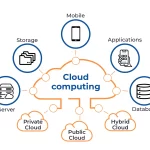Cloud Computing
/ /
Cloud computing has emerged as a game-changing technology, revolutionizing the way businesses and individuals store, access, and process data. From small startups to large enterprises, cloud computing has provided a scalable and flexible infrastructure, enabling innovation, enhancing efficiency, and transforming industries. In this blog, we will explore the world of cloud computing, its key benefits, and its potential to shape the future.
- Understanding Cloud Computing: At its core, cloud computing refers to the delivery of computing resources, including servers, storage, databases, software, and networking, over the internet. Rather than relying on physical infrastructure, users can access and utilize these resources on-demand, paying only for what they use. Cloud computing offers a shared pool of resources that can be rapidly provisioned, scaled, and released, providing agility and cost-effectiveness.
- Scalability and Flexibility: One of the key advantages of cloud computing is its scalability. Businesses can quickly scale their resources up or down to meet their changing needs. This flexibility allows organizations to handle spikes in demand, launch new products or services, and adapt to market dynamics without the need for significant upfront investments in hardware or infrastructure.
- Cost Savings: Cloud computing offers significant cost savings compared to traditional on-premises infrastructure. With cloud services, businesses can avoid upfront hardware costs, ongoing maintenance, and the need for dedicated IT personnel. The pay-as-you-go model allows for better cost control, as organizations only pay for the resources they consume. Additionally, cloud services eliminate the need for hardware upgrades, reducing the total cost of ownership.
- Enhanced Collaboration and Productivity: Cloud computing facilitates seamless collaboration and productivity across teams, regardless of location. Cloud-based productivity tools, such as Google Workspace and Microsoft Office 365, enable real-time document editing, file sharing, and project management. Team members can collaborate on projects simultaneously, improving efficiency, and reducing time-to-market.
- Data Storage and Disaster Recovery: Cloud storage provides a secure and reliable solution for data storage and backup. Data stored in the cloud is protected from hardware failures, theft, or natural disasters. Cloud service providers offer robust data backup and disaster recovery capabilities, ensuring business continuity and minimizing the risk of data loss.
- Innovation and Agility: Cloud computing fuels innovation by providing easy access to cutting-edge technologies and services. Organizations can leverage cloud platforms to experiment, develop, and deploy new applications rapidly. Cloud-based machine learning, artificial intelligence, and analytics services enable businesses to extract valuable insights from data, enhance decision-making, and deliver personalized experiences to customers.
- Global Reach and Accessibility: The cloud transcends geographical boundaries, offering global reach and accessibility. Cloud services can be accessed from anywhere with an internet connection, empowering remote work and enabling businesses to tap into a global talent pool. Cloud computing also facilitates the delivery of applications and services to customers worldwide, ensuring a seamless user experience regardless of location.
- Environmental Sustainability: Cloud computing promotes environmental sustainability by optimizing resource utilization. The shared nature of cloud infrastructure ensures efficient use of computing resources, minimizing energy consumption and carbon footprint. Additionally, cloud services provide virtualization capabilities, allowing organizations to consolidate their IT infrastructure and reduce hardware waste.
Posted in Blogs


































